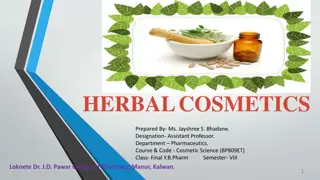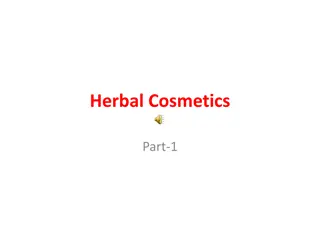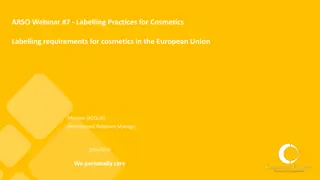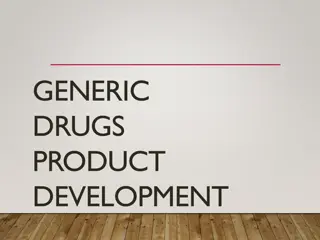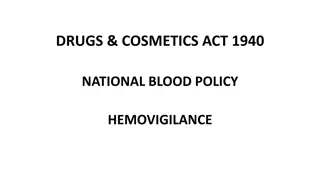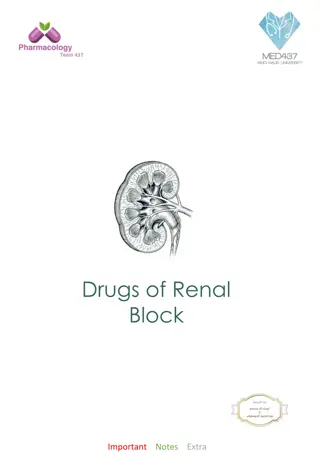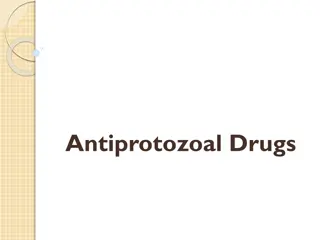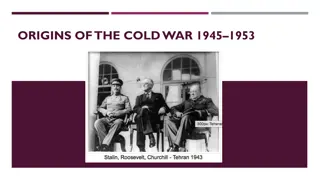Overview of Drugs and Cosmetics Act, 1940 and Its Rules 1945
The Drugs and Cosmetics Act of 1940 and its Rules of 1945 were established to regulate the import, manufacture, distribution, and sale of drugs and cosmetics in India. The Act ensures that only qualified individuals are involved in these processes and aims to prevent the entry of substandard or spurious drugs into the market. Special provisions are in place for different classes of drugs and cosmetics, including Ayurvedic, Siddha, Unani, and Homeopathic products. Various chapters within the Act address topics such as technical advisory boards, import regulations, manufacturing standards, and amendments over the years.
Download Presentation

Please find below an Image/Link to download the presentation.
The content on the website is provided AS IS for your information and personal use only. It may not be sold, licensed, or shared on other websites without obtaining consent from the author.If you encounter any issues during the download, it is possible that the publisher has removed the file from their server.
You are allowed to download the files provided on this website for personal or commercial use, subject to the condition that they are used lawfully. All files are the property of their respective owners.
The content on the website is provided AS IS for your information and personal use only. It may not be sold, licensed, or shared on other websites without obtaining consent from the author.
E N D
Presentation Transcript
Drugs and Cosmetics Act, 1940 and its Rules 1945 Course Content:- (Unit-I & II) Dr. Prakash Chandra Gupta Assistant Professor University Institute of Pharmacy C.S.J.M. University, Kanpur
Introduction The Drug & Cosmetic Act was passed in 1940 and Rules 1945 with the objective of : Regulating Import, manufacture, distribution and sale of drug & cosmetics The act provide for the manufacture, distribution and sale of drugs and cosmetics by qualified and trained persons only The act regulates the import of drugs in India, so that no substandard or spurious drug will enter into India.
The act prohibits the manufacture of substandard or spurious drug in the India. The act also provide for the control over the manufacture, sale & distribution of Ayurvedic, Siddha, Unani & Homeopathic drugs To establish Drugs Board(DTAB) and Drugs Consultative Committees (DCC) for Allopathic and allied drugs and cosmetics. Regular inspection of licensed premises by drug inspectors. . Technical Advisory
. Act provide special provisions to regulate the preparation, standardization biological & special products. To prescribe the manner of labeling & packing of the various classes of drugs & cosmetics. & storage of
Chapters of the act CHAPTER I: INTRODUCTORY CHAPTER II: THE DRUGS TECHNICAL ADVISORY BOARD, THE CENTRAL DRUG LABORATORY, THE DRUGS CONSULTATIVE COMMITTEE CHAPTER III: IMPORT COSMETICS CHAPTER IV: MANUFACTURE, DISTRIBUTION OF DRUGS CHAPTER IV-A: PROVISIONS AYURVEDIC, SIDDHAAND UNANI DRUGS CHAPTER V: MISCELLANEOUS OF DRUGS AND SALE COSMETICS RELATING AND AND TO
LIST OF AMENDING ACTS AND ADAPTATION ORDERS The Drugs (Amendment) Act, 1955 The Drugs (Amendment) Act, 1960 The Drugs (Amendment) Act, 1962 The Drugs and Cosmetics (Amendment) Act, 1964 The Drugs and Cosmetics (Amendment) Act, 1972 The Drugs and Cosmetics (Amendment) Act, 1982 The Drugs and Cosmetics (Amendment) Act, 1995 The Drugs and cosmetics (Amendment) Act, 2008 The Drugs and cosmetics (Amendment) Act, 2017 The Drugs and cosmetics (Amendment) Act, 2018 Duration of license Inspection for grant of license and verification of compliance Inspection for verification of compliance The Drugs and cosmetics (Amendment) Act, 2019
DEFINITIONS Drugs: All medicines for internal or external use of human beings or animals and all substances intended to be used for or in the diagnosis, treatment, mitigation or prevention of any disease or disorder in human beings or animals, including preparations applied on human body for the purpose of repelling insects like mosquitoes.
. Cosmetic: Any article intended to be rubbed, poured, sprinkled or sprayed on, or introduced into, or otherwise applied to, the human body or any part thereof for cleansing, beautifying, promoting attractiveness, or altering the appearance and includes any article intended for use as a component of cosmetic.
. Misbranded drugs: if it is so colored, coated, powdered or polished that damage is concealed or if it is made to appear of better or greater therapeutic value than it really is; or if it is not labeled in the prescribed manner; or if its label or container or anything accompanying the drug bears any statement, design or device which makes any false claim for the drug or which is false or misleading in any particular.
. Adulterated drug : A drug shall be deemed to be adulterated if it consists, in whole or in part, of any filthy, putrid or decomposed substance; or if it has been prepared, packed or stored under insanitary conditions whereby it may have been contaminated with filth or whereby it may have been rendered injurious to health; or if its container is composed in whole or in part, of any poisonous or deleterious substance which may render the contents injurious to health;
. Spurious drugs: A drug shall be deemed to be spurious If it is imported under a name which belongs to another drug; or If it is an imitation of, or a substitute for, another drug or resembles another drug in a manner likely to deceive or bears upon it or upon its label or container the name of another drug unless it is plainly and conspicuously marked so as to reveal its true character and its lack of identity with such other drug; or
. If it has been substituted wholly or in part by another drug or substance; or If it purports to be the product of a manufacturer of whom it is not truly a product. Misbranded cosmetic: A cosmetic shall be deemed to be misbranded If it contains a colour which is not prescribed; or If it is not labeled in a prescribed manner; or If the label or container accompanying the cosmetic bears any statement which is false or misleading in any particular. or anything
. Spurious cosmetic: A cosmetic shall be deemed to be spurious if If it is imported under the name which belongs to another cosmetic; or If it is an imitation of, or is a substitute for, another cosmetic or resembles another cosmetic in a manner likely to deceive or bears upon it or upon its label or container the name of another cosmetic, unless it is plainly or conspicuously marked so as to reveal its true character and its lack of identity with such other cosmetic; or
. If the label or the container bears the name of an individual or company purporting to be the manufacturer of the cosmetic, which individual or company is fictitious or does not exist; or purports to be the product of a manufacturer of whom it is not truly a product. If it
. Patent or proprietary medicine: Means In relation to Ayurvedic, Siddha or Unani systems of medicine all formulations containing only such ingredients mentioned in the formulae described in the authoritative books of Ayurveda, Siddha or Unani systems of medicine specified in the First Schedule, but does not include a medicine which is administered by parenteral route and also a formulation included in the authoritative books as listed in the First Schedule;
. In relation to any other systems of medicine, a drug which is a remedy or prescription presented in a form ready for internal or external administration of human beings or animals and which is not included in the edition of the Indian Pharmacopoeia for the time being or any other Pharmacopoeia authorized in this behalf by the Central Government after consultation with the Drugs Technical Advisory Board
. Manufacture: Manufacture in relation to any drug or cosmetic includes Any process or part of a process for making, altering, ornamenting, labelling, breaking up or otherwise treating or adopting any drug or cosmetic with a view to its sale or distribution but does not include the compounding or dispensing of any drug, or the packing of any drug or cosmetic, in the ordinary course of retail business. finishing, packing,
. Homeopathic medicines: Include any drug which is recorded in Homeopathic proving or therapeutic efficacy of which has been established through long clinical experience as recorded in authoritative homeopathic literature of India and abroad and which is prepared according to the techniques of Homeopathic Pharmacy and covers combination of ingredients of such homeopathic medicines but does not include a medicine which is administered by parenteral route.
Schedules to the Act & Rules First Schedule: List of Ayurvedic, Siddha & Unani books Ayurvedic books Charak Samhita Sushrut Samhita, Vaidya Chintamani Ayurveda Chintamani Siddha Books Siddha vaidya Thiratu, Nagmuni Bhogar (700) Unani books Karabadin Quadri Karabadin Kabir Karabadin Azam
. Second Schedule: Standards to be complied with by imported drugs & by drugs manufactured for sale, sold, stocked or exhibited for sale or distribute Schedules to the Rule A: List of forms for making applications for issuing licences, granting licences, sending memorandum B: Fees for test or analysis by the Central Drugs Laboratory C: List Of biological and special products (Injectable) applicable to special provisions.
. C1: List of other special products whose import, sale, distribution and manufacture are governed by special provisions D: Classes of exempted exempted from certain provisions applicable to import of drugs E(1): List of poisinous substances under the Ayurvedic, Siddha, and Unani poisons F: Provisions applicable (Requirements and licencing process) drugs which are to blood bank
. F (I) : Provisions applicable to other biological and special products such diagnostic antigens, tuberculin, etc. regarding their production, testing, storage, packing, etc. F (II) :Standards for Surgical dressings and bandage cloth. F (III): Standard for umbilical tapes. FF: Standards for ophthalmic preparations. G: List of substances required to be used under medical supervision and labelled accordingly. H: List of substances (prescription) that should be sold by retail only on prescriptions of R.M.P as vaccines, antigens,
. J: List of diseases and ailments that drug should not claim to cure K: List of drugs that are exempted from certain provisions regarding manufacture M: Good manufacturing factory premises, plants and equipments M1: Requirements of factory premises for manufacture of homeopathic medicines M2: Requirements of factory premises for manufacture of cosmetics M3: Requirements of factory premises for manufacture of medical devices requirement of
. N: List of equipment to run a pharmacy O: standards for disinfectant fluids P: Life period(expiry) of drugs P 1: Pack size of certain drugs. Q: List of coaltar colours permitted to be used in drug and cosmetics R: Standards for mechanical contraceptives R1: Standards for medical devices S: Standards for cosmetics T: Requirements (GMP) of factory premises for ayurvedic, siddha, unani drugs
. U: Manufacturing and analytical records of drugs U1: Manufacturing and analytical records of cosmetics V: Standards for patent or proprietary medicines W: List of drugs marketed under generic names X: List of narcotic drugs and psychotropic substances Y: Requirement and guidelines on clinical trials for import and manufacture of new drugs
Administration of the act and rules A) Advisory : Drugs Technical Advisory Board-DTAB Drugs Consultative Committee-D.C.C. B) Analytical : 1)Central Drugs Laboratory - CDL 2)Drug Control Laboratory in states 3)Government Analysts C) Executives : 1)Licensing authorities 2)Controlling authorities 3)Drug Inspectors
Administration of the act and rules DTAB is constitute by Central government. It consist of 18 members, of whom 8 are ex-officio members, 5 nominated and 5 elected members. Ex-Officio Members: 1. Director General of Health Services (Chairman) 2. Drugs Controller of India 3. Director of the Central Drugs Laboratory, Calcutta 4. Director of the Central Research Institute, Kasauli 5. Director of Indian Veterinary Research Institute, Izatnagar
. 6. President, Pharmacy Council of India 7. President, Medical Council of India 8. Director of Central Drug Research Institute, Lucknow Nominated Members: 1. Two persons nominated by the Central Government from among persons who are in charge of drugs control in the States 2. One person nominated by the Central Government from the pharmaceutical industry 3. Two persons holding Government Analyst nominated by the Central Government the appointment this Act, of be under to
. Elected Members: 1. One person, to be elected by the Executive Committee of the Pharmacy Council of India, from among teachers in Pharmacy or Pharmaceutical chemistry or Pharmacognosy on the staff of an Indian university or an affiliated college 2. One person, to be elected by the Executive Committee of the Medical Council of India, from among teachers in medicine or therapeutics on the staff of an Indian University or an affiliated college 3. One pharmacologist to be elected by the Governing Body of the Indian Council of Medical Research
. 4. One person to be elected by the Central Council of the Indian Medical Association 5. One person to be elected by the Council of the Indian Pharmaceutical Association Functions: To advise the Central Government and the State Governments on technical matters arising out of the administration of this Act. Modification & Amendments consultation of Board. To carry out the other functions assigned to it by this Act. The nominated and elected members of the Board shall hold office for three years, but shall be eligible for re-nomination and re-election in the Act with
Drugs Consultative Committee(DCC) It is also an advisory body constituted by central government. Constitution: Two representatives of the Central Government One representative of each State Government Drugs Consultative Committee(DCC) DCC advise the Central Government and State Governments and the Drugs Technical Advisory Board on any other matter tending to secure uniformity throughout India in the administration of this Act. The Drugs Consultative Committee shall meet when required Has power to regulate its own procedure.
Central Drug Laboratory (CDL) Establishment of Central Drug Laboratory under the control of a director appointed Government. Functions: Analysis of samples of drugs and cosmetics sent by the custom collectors or courts. Analytical Q.C. of the imported samples. Collection, storage and distribution of internal standards Preparation of reference standards and their maintenance Maintenance of microbial cultures. Advise the central drug control administration in respect of quality & toxicity. by the Central
Government Analyst State Government may appoint such persons, having prescribed qualification as Government Analysts for the purpose of analysis/testing of samples of drugs and cosmetics. The central government may also appoint such person as a Government Analysts. Person who is directly or indirectly engaged in any trade connected with manufacture or sale of drugs & cosmetics can not be appoint as Government Analyst
. QUALIFICATION: person should be:- Graduate in medicine or science or pharmacy or Pharmaceutical chemistry and have 5 year post graduate experience in testing of drug in a laboratory A postgraduate degree in medicine or science or pharmacy OR pharmaceutical chemistry and with at least 3 years experience in testing of drugs in laboratory Holding associateship Diploma of the Institution of Chemists with Analysis of drugs & pharmaceuticals with at least 3 year experience in testing.
. Duties of Government Analyst: o To cause analysis or testing of samples of drugs or cosmetics sent to him by Drug Inspectors or other persons under the provisions of the Act and furnish reports as per rules. o Forward from time to time reports giving the results of analysis work and research with a view to their publication at the discretion of the Government. Procedure On receipt of samples Government Analyst should record the condition or the seal and compare the seals with impression of the seal received separately After completion of the analysis the report in triplicate with full protocols applied should be sent to the inspector. from an Inspector the
Licensing Authorities For licensing authorities to issue or renewal of licences for the import of drugs. For manufacture and sale: The state governments appoint licensing authorities for respective territories to issues licence for the sale of drugs and for the manufacture and sale of drugs and for manufacture of cosmetic. The Drug Controller of India has been notified as the Central License Approving Authority import: The central government appoints
. Qualification A graduate in Pharmacy or Pharmaceutical Chemistry or Medicine with specialization Pharmacology or Microbiology from a recognized university At least 5 year experience in the manufacture or testing of drugs or enforcement of the provision of the Act. in clinical
Controlling Authority Drug Inspectors at central and state level are under the control of controlling authority. Qualifications : He is a graduate in Pharmacy / Pharmaceutical chemistry / Medicine with specialization in Clinical pharmacology or Microbiology from a University established in India He has experience in manufacturing or testing of drugs or enforcement of the provisions of the Act for a minimum period of 5 yrs.
Drug Inspector Central and State Government are empowered to appoint a qualified persons as Drug Inspectors to inspect premises licensed for manufacture of drugs & cosmetics & sale of drugs. Drug Inspectors should have no any financial interest in the import, manufacture or sale of drugs and cosmetics. Drug Inspectors are deemed to be public servant. Drug Inspectors are required to keep all information's confidential & not to disclose.
. Qualifications of Drug Inspectors A graduate in Pharmacy or Pharmaceutical Sciences or Medicine with specialization in Clinical Pharmacology or Microbiology from a recognized University. Provided that for the purpose of Inspection of Manufacture of substances specified in Schedule C, a person appointed as a Drug Inspector should have o Not less than 18 months manufacture of at least one of the substances specified in Schedule C; or o Not less than 18 months experience in testing of at least one of the substances specified in Schedule C in a approved laboratory; or experience in the
. o Not less than 3 years experience in the inspection of firms manufacturing any of the substances specified in Schedule C during the tenure of their services as the Drug Inspectors
. Powers of Inspectors: Inspect: i. Inspection of any premises wherein any drug or cosmetic is being manufactured and he may also inspect the means employed for standardizing and testing the drug or cosmetic ii. Any premises wherein any drug or cosmetic is being sold or stocked or exhibited or offered for sale or distributed Take samples of any drug or cosmetic: i. He may take sample which is being manufactured or being sold or is stocked or offered for sale or exhibited or being distributed
. ii. Take sample from any person conveying, delivering or preparing to deliver any drug or cosmetic to a purchaser or a consignee iii. With necessary assistance, search any person who has secret about his person, any drug or cosmetics in respect of which an offence relating to manufacture, sale, distribution under has been or is being committed at all reasonable times iv. Enter and search at all reasonable times, any place or premises in which he has reason to believe that an offence is being committed or has been committed
. v. Stop and search any vehicle or conveyance which he has reason to believe, used for carrying any drug or cosmetic in respect of which offence has been or is being committed vi. Examine any record, register, document, or any other material object found while exercising above powers and seize the same if he has reason to believe that it is an evidence of commission of an offence under the Act viii. Exercise any other powers as may be necessary, for carrying out the purpose of this Act and the Rules made there under.
. Duties of Drug Inspectors: Classified under 2 heads A) Inspection of premises, licensed for the sale of drugs. B) Inspection of premises licensed for the manufacture of drugs & cosmetics Inspection of sale premises Inspect not less than twice a year all shops within the area assigned to him He satisfy himself that the conditions of licenses are being fulfilled or not. Procure and send the samples for analysis, if necessary.
. Investigate any written complaints Maintain a record of all inspection made and action taken by him Enter and search where an offence is believed to be committed. Exercise other duties as may be necessary Inspection of manufacturing premises To inspect not less than once a year all shops licensed for manufacture of drug within the area assigned to him. If establishment licensed to manufacture of biological products specified in schedule C & C1, inspect the plant and the process of manufacturing, standardizing and testing of drugs and method of storage, technical qualification of the staff.
. Procedure of Drug Inspectors : Taking any samples of drug and dispatching them to laboratory: i. Whenever Drug Inspector take sample of drug or cosmetics, he may require a written acknowledge for the same. ii. He should pay its fair price and if price is not accepted he should issue a receipt for the same in prescribed form iii. Where an Inspector takes a sample of a drug or cosmetic for the purpose of test or analysis, he shall intimate such purpose in writing in the prescribed form to the person from whom he takes it and, in the presence of such person unless he willfully absents himself.
. iv. He should divide the sample into four portions and each portion should be sealed and suitably mark. v. The sample from whom taken should be permit o add his own seal and mark to all or any of the portions so sealed and marked. vi. When the sample is taken from manufacturing premises, it should be necessary to divide the sample into three portions only. vii. Where the sample is made up in containers of small volume or is likely to deteriorate or be otherwise damaged by exposure, the Inspector shall take three or four such containers after suitably marking the same and, where necessary, seal them.
. viii. The Inspector shall restore one portion of a sample to the person from whom he takes it, and second portion is sent to the Government Analyst for test or analysis, third is reserved for the court, if required and fourth is sent to warrantor, if any. Seizure of stocks: Whenever an inspector suspects contravention of the Act, he may seize any stock of such drug or records, registers, documents which are believed to be evidence of commission of offence, he should as soon as may be, inform a Judicial Magistrate and take his order for custody.
Import of drugs and cosmetics 1. Classes of drugs prohibited to import. 2. Import of drug under license i. Specified in Schedule C/C1 ii. Specified in Schedule X iii. Imported for Test/Analysis iv. Imported for personal use v. Import of Homeopathic & Cosmetics Drugs 3. Drugs exempted from provisions of import 4. Offences and Penalties





